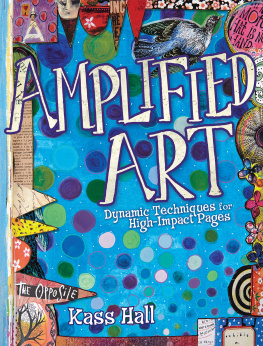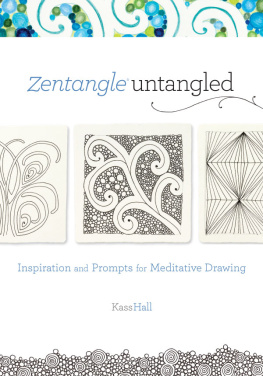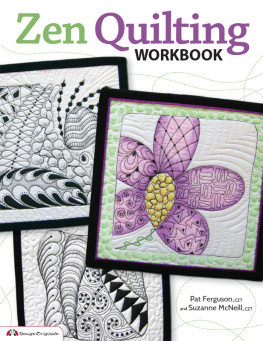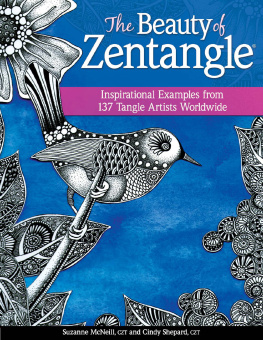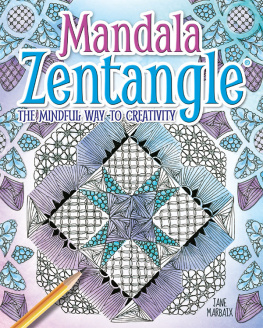The Zentangle
Untangled Workbook
A Tangle-a-Day to Draw Your Stress Away
Kass Hall
Cincinnati, Ohio
CreateMixedMedia.com
Contents
Introduction
Welcome to The Zentangle Untangled Workbook! Im glad youre here.
The Zentangle Untangled Workbook is a complement to my first book, Zentangle Untangled. In that, I wrote about my Zentangle experience, explained how to get started and demonstrated many ways you could use Zentangle in other artistic pursuits.
This workbook is a little different from the last book. Here we work with the three tangle patterns I introduced in Zentangle Untangled (Honeycomb, Starfish and Five-Oh), as well as four brand-new tangles that I have developed especially for this workbook. Youll see many other tangles throughout the workbook, but these seven are the ones we will break down, step-by-step, and really develop ideas for.
I have taken a very stripped-back approach to this workbook compared to Zentangle Untangled, which I hope will suit beginners on the Zentangle juggernaut, as well as provide some inspiration and guidance to those further into their exploration of the art form. This means that we will take a slow, step-by-step journey through each tangle, working through ideas and refining our skills.
I have not sought to replace the experience you receive in a class taught by a Certified Zentangle Teacher. Learning from a CZT remains the best way to begin and enjoy the Zentangle process. New CZTs all across the world are gaining certification regularly. I hope this workbook will supplement those classes and provide an alternative for those who dont have easy access to a CZT.
The Zentangle Untangled Workbook is a year long format to help you pace yourself while being introduced to Zentangle basics. I know that youre likely to skip ahead often, and thats perfectly OK. Ive organized the book to suit a relaxed pace in keeping with the relaxed nature of Zentangle.
This workbook provides space to practice what youre learning. I strongly encourage you to tangle straight into this book and to not be afraid of spoiling anything. Remember, with Zentangle there is no scope for being wrong. Mistakes do not exist here. So, go right aheaddraw directly onto the following pages in pen. For further practice, get yourself a stash of Zentangle tiles or maybe a notebook that you can experiment in.
During the first week youll practice some basic skills and concepts, such as drawing straight lines and circles, shading and adding color, as well as introducing Zendalas to the mix (Zentangle + mandala = Zendala). You can do these exercises to warm yourself up for the weeks ahead, or you can come back to them as you wish.
We then take each of the seven tangles and spend a week really practicing each element:
Week 1: Step-out process for the tangle
Week 2: Shading the tangle
Week 3: Using color
Week 4: Using the tangle as a page/tile border
Week 5: Creating letterforms
Week 6: Creating shape
Week 7: Zendala fun
Each week includes examples of how to use these elements and provides practice areas for you to have a go. Remember, mine are just suggestions. You are welcome and encouraged to do your own thing!
At the end of the book there are some pages with blank tiles printed onto them for general practice. You may want to use these as you go or as a place to combine your newly acquired talents when youve completed the workbook. Thats completely up to you.
So, grab your pen, turn the page and lets get started!
Materials
In Zentangle Untangled, I wrote about the official Zentangle Kit and the materials used by CZTs. Anyone who has purchased a kit will probably agree this is the best way to start out. The Fabriano paper tiles and the Sakura Pigma Micron pens included in the kit are high quality materials, and if you can buy a kit, Id encourage you to do so.
With that said, not having a kit or expensive art materials should not stop you from exploring the Zentangle art form. Use whatever supplies you have (including this workbook).
I recommend the Strathmore spiral-bound art journals because they lay flat. I think bristol paper works well. The sketchbooks are relatively inexpensive and are perfect for keeping your tangle practice all in one place.
I used the 512" 8" (14cm 20cm) size when playing with and practicing the new tangles I created for this workbook. Its a handy size to keep in your bag or purse, so its easy to have it always within reach for whenever an idea comes to mind.
Youll definitely need a graphite pencil. I also think the Faber-Castell Pitt artist pens are great.
But whatever you have in your art supply stash will do to begin with. We dont pass judgment on art supplies here.
CHAPTER 1
WEEK 1: Warm-Up Week
This week is the busiest in the whole workbook, so I want to say up front: dont feel pressured. This is a warm-up week, and it is not as difficult or intimidating as it may look. This is the only week with daily activities. These are to get you started, to get you in the habit of practicing and to introduce some basic concepts. You dont have to do everything if you dont want to or dont have time. You can come back at any time and fill in the gaps.
Remember, there are no rules, no homework and no wrong turns.
I dont introduce a new tangle this week. So play with what you already know, invent your own or look at the vast resources available in Zentangle Untangled or online for ideas.
I cannot emphasize enough that there are no mistakes in Zentangle. Some people demonstrate immediate talent; some take time to practice. With all art forms, practice really is the key. Im proof of that. When I began art school, I announced at orientation that I do not draw. You are now reading my second book about Zentangle, a drawing form. Everything requires an open mind, a little practice and the belief that you can succeed. I know you can. Now its your turn to shine.
DAY 1: Straight Lines and Circles


